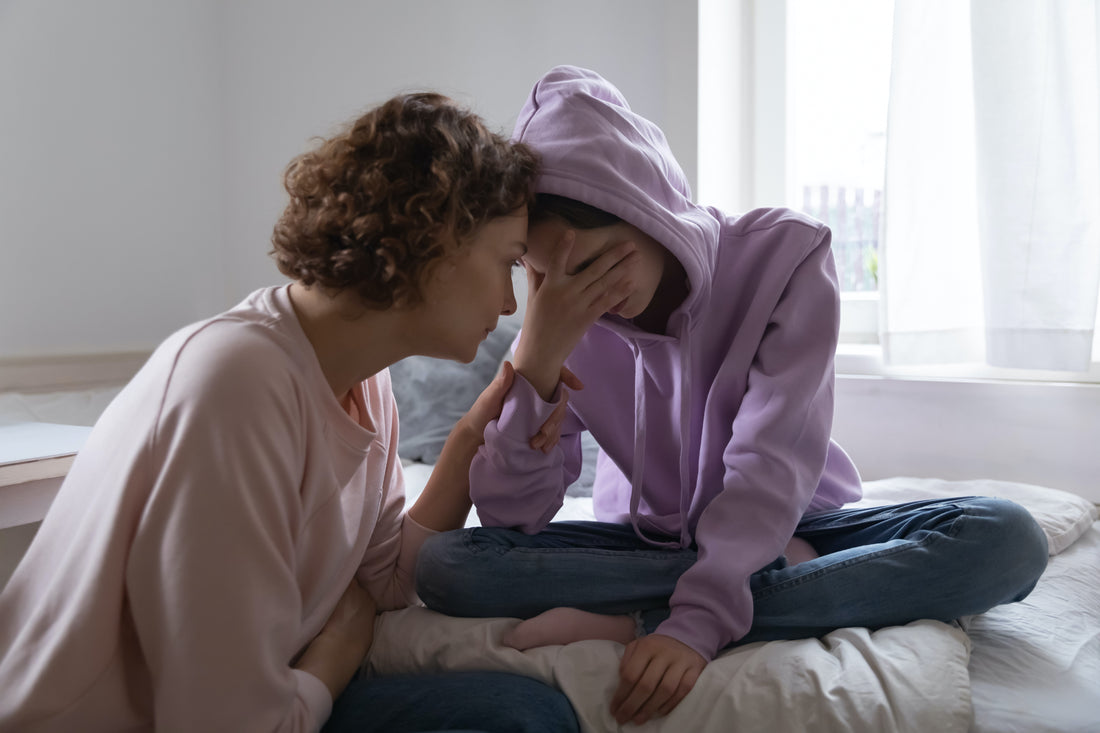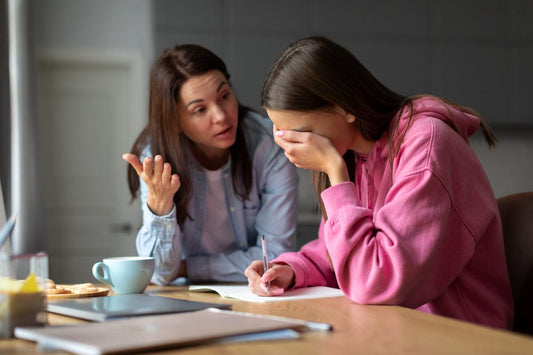While all children get anxious from time to time, when it happens frequently and affects their schoolwork, relationships, and overall happiness, they may be suffering from an anxiety disorder. The CDC reports that 7.1 percent of children have diagnosed anxiety in the U.S. and cases are increasing every year.1 For many children, anxiety co-occurs with other mental health conditions like depression, ADHD, and behavior problems. Early intervention is crucial, as experts say that when anxiety is ignored, it can affect grades, academic performance, social and interpersonal skills, and life outcomes.2 The longer one waits, the more vulnerable a person is for developing depression and even substance-use problems later in life.
If you suspect your child may have anxiety, find out what early signs you should look for, common symptoms they may have, and lastly, how to help your anxious child succeed.
What Makes Children Anxious?
From monsters under the bed to missing Mom and Dad, some anxiety in children comes with the territory of being in a new and unfamiliar world. They may become anxious about moving or starting school. Or they may notice people around them being anxious and model their behavior. But when anxiety becomes frequent and starts to affect your child’s daily life or functioning, there may be a bigger problem that needs to be addressed.
There is no single cause of anxiety in children, though researchers have pointed to some risk factors.3 This includes biological factors, such as genetics and brain wiring, psychological factors, such as temperament and coping strategies, and environmental factors, like being bullied or parented by an anxious caregiver. In some cases, anxiety in children is a side effect of medicine, such as prescription stimulants used to treat ADHD.
First Signs of Anxiety in Infants
According to the American Psychological Association, the typical age of onset for anxiety in children is 11. However, symptoms can show up much earlier than that. Research pioneered by Harvard University developmental psychologist Jerome Kagan, PhD indicates that infants and toddlers who are behaviorally inhibited—clinging to parents, hiding, failing to explore their environments—are much more likely to exhibit anxiety later in childhood.4
Separation anxiety is the most common type of anxiety disorder in children, characterized by clinging to caregivers, extreme tantrums, refusing to do things that require separation from parents or caregivers, and refusal to sleep alone or waking up frequently during the night.
Early signs of anxiety and depression may even be evident in newborns. In a study at Washington University School of Medicine in St. Louis researchers analyzed brain scans of newborns and found connections between certain brain regions that predicted the likelihood of the babies developing excessive sadness, shyness, nervousness or separation anxiety by the age of two.5 Such symptoms were then linked to clinical depression and anxiety disorders in older children and adults.
What Are the Major Signs of Anxiety in Toddlers?
Research shows that 10 percent of children ages two to five show signs of an anxiety disorder.6 If your child’s fears seem to be out of proportion to a situation or when they persist to the point of disrupting their life, it may be time to step in and help.
Some early signs of anxiety in toddlers include:
- Restlessness
- Tics
- Trouble falling or staying asleep
- Nightmares
- Trembling or shaking
- Aggression
- Being overly sensitive
- Teariness
- Frequent meltdowns or tantrums
- Changes in eating habits
- Repetitive behaviors
Ready to try Brillia?

Anxiety Symptoms in Children 5-10
From finding it difficult to concentrate to not eating properly, there are many other anxiety symptoms to monitor in older children. Triggered by such normal events as going to school, taking a test, attending a birthday party, or going to the doctor, this anxiety may seem like shyness, or maybe defiance, at first. But when anxiety occurs frequently, it can cause extreme distress.
Signs of anxiety in children aged five to 10 include:
- Finding it difficult to concentrate: While some children with anxiety also have ADHD, an inability to concentrate doesn’t necessarily mean they have an attention disorder. Younger children with separation anxiety may be distracted by thoughts of something bad happening to their parents, while older kids struggling with perfectionism might worry about making mistakes.
- Poor sleep: Younger children are often afraid of sleeping away from their parents due to a fear of the dark or nightmares. Older children may not be able to fall asleep due to worries about the day. Some might even fear not being able to fall asleep or stay asleep.
- Low frustration tolerance: Kids with anxiety are often quick to anger or irritability, especially when they feel like they can’t escape an overwhelming situation. In some cases, children will give up on tasks without really trying at the first sign of frustration.
- Poor eating habits: Many anxious kids lose their appetite, sometimes due to stomach aches caused by their anxiety. A loss of appetite may result in low food intake, leading the child to be underweight and/or lethargic. Other children may respond to their anxiety and stress by overeating.
- Frequent outbursts: While occasional tantrums are common in younger children, kids often outgrow them by kindergarten. If your child is anxious, they may try to hide their emotions by disrupting the class or lashing out.
- Headaches and tummy aches: What might seem like a stomach bug or some other illness may actually just be anxiety. You might notice a pattern of your child suddenly feeling unwell before a triggering situation like a test or athletic event.
How to Help Your Anxious Child
When a child is struggling with anxiety, there are many coping mechanisms that can help. While your doctor may suggest prescription medication, most pharmaceutical drugs contain harsh, synthetic chemicals that are associated with side effects like headaches, nausea, diarrhea, dry mouth, nervousness, insomnia, and weight changes. These drugs often mask symptoms without addressing the root cause of them.
A gentle alternative to prescription drugs is Brillia, a homeopathic medication that uniquely uses antibody ingredients to target symptoms of anxiety, stress, irritability, and impulsivity at the source, binding to the very proteins that instigate such symptoms and stopping them in their tracks. This is achieved without any harsh chemicals or harmful side effects, making Brillia safe and impactful for children as young as five. And if your child is already taking medication for their anxiety, Brillia can be safely added to their regimen because there are no contraindications.
Taking Brillia is just one component to the holistic approach known as the Five Pillars, which outlines various lifestyle factors proven to ease anxiety, combining healthy living with antibody science for long-term success.
These healthy lifestyle factors include:
- Proper nutrition: Encourage your child to eat healthy food and steer clear of anxiety-provoking culprits like sugar, caffeine, and processed foods.
- Adequate sleep: Ensure your child gets enough sleep to regulate their mood and improve memory and concentration.
- Mindfulness and relaxation techniques: Incorporate mindfulness and relaxation techniques into their life, such as meditation, yoga, breathing exercises, and more.
- Controlled screen time: Limit your child’s screen time to reduce stress and promote calmness and face-to-face interaction.
When to Contact a Professional
If you find that your child’s anxiety is persistent and impacting various aspects of their life, such as academics and family life, it may be helpful to contact a therapist or counselor for advice. A mental health professional trained in cognitive behavioral therapy (CBT) will be able to help your child understand their feelings and learn coping mechanisms to deal with their anxiety triggers.
It’s important to note that sometimes symptoms of anxiety may not be obvious, but if you sense something is wrong it’s worth investigating. You might even want to have a conversation with their teacher to understand how your child is behaving outside of the home. Ask if your child has been isolating, refusing to participate in class, or having trouble connecting with their peers, which are all signs of anxiety.
Additional Methods & Treatments
While your child may be feeling anxious today, giving them a range of tools to help them feel calmer and more balanced will empower them to have a less anxious tomorrow. Beyond therapy, healthy lifestyle changes, and medication, some other additional methods to consider include:
- Teaching your child positive self talk
- Taking parenting classes to learn how to support your child more effectively and respond to their anxiety7
- Establishing daily routines so your child isn’t triggered by unpredictability
- Signing your child up for a music class
- Encouraging your child to participate in extracurricular activities
Another important aspect of helping your child with anxiety is to model healthy coping mechanisms yourself. If you also struggle with anxiety, addressing your own struggles will empower them to face their own.
Find out more about how Brillia works for children & teens and adults and visit the Brillia blog for more resources on how to help your child cope with anxiety.
Get a whole bunch of support right in your inbox.







